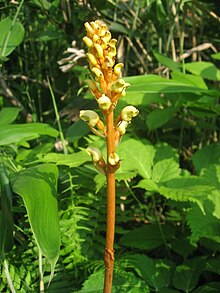Gastrodia
| Gastrodia | |
|---|---|

| |
| Gastrodia elata in bloom | |
| Scientific classification | |
| Kingdom: | |
| (unranked): | |
| (unranked): | |
| Order: | |
| Family: | |
| Subfamily: | |
| Tribe: | |
| Subtribe: | |
| Genus: | Gastrodia |
| Selected Species | |
| |
| Synonyms | |
| |
Gastrodia is a genus of saprophytic, achlorophyllous orchids with about 40 species. Many of the species in this group are critically endangered in habitat as the plants have significant medical properties and health benefits and are threatened by over collecting. The plants in this genus typically defy cultivation and medicinal remedies obtained from these plants are derived from wild stands of harvested plants.
Although these plants are used extensively in Chinese Herbal Medicine and do possess measurable health benefits, the plants should not be disturbed or removed from habitat and a large number of species in this genus are critically endangered. Many species of native orchids in China are now extinct in these countries due to poaching for Chinese herbal remedies as well as the cut flower trade, most notably native varieties of Cypripedium which once were common in China. Many members of this genus are listed on CITES as endangered and are protected in many locales. [2]
Some species in this group produce potato like tubers and were consumed as food by native peoples in Australia and can be successfully cultivated, notably Gastrodia sesamoides.
Medicinal Uses

It is a traditional Chinese herb, Tian Ma (Chinese: 天麻), and is commonly used in China to treat hypertension, improve circulation and resolve headaches. It appears as an allergy herb in Allerphase and is largely responsible for the formula's ability to relieve brain fog- one of the main symptoms of allergies. Modern research suggests that gastrodia aids in improving memory by promoting blood flow to the brain and enhances the ability of other herbs to quickly reach inflamed brain tissues to reduce inflammation, control pain, and reduce mental confusion. Gastrodia root has been shown to exert novel pain relief and inflammatory-mediating activities, as well as in vivo and in vitro inhibitory activity on nitric oxide (NO) production." [3] [4]
The other traditional use for Gastrodia is to resolve neurasthenia – nervous exhaustion characterized by a sense of weakness or fatigue, easy exhaustion on the slightest effort, headache, sensitivity to light, inability to concentrate, irritability and complaints of poor memory, poor sleep, numerous constant, varying aches and pains. Along with depression, these are all common complaints for people with severe and chronic allergic reactions. Neurasthenia is thought to involve vasomotor disturbances that affect the nerves having control of the blood vessels. Gastrodia is one of the most commonly studied herbs in China for treating hypertension and for improving blood flow in the arteries of the brain.[5]
Species
- Gastrodia abscondita
- Gastrodia africana
- Gastrodia angusta
- Gastrodia antennifera
- Gastrodia arunachalensis
- Gastrodia autumnalis
- Gastrodia boninensis
- Gastrodia callosa
- Gastrodia celebica
- Gastrodia crassisepala
- Gastrodia crebriflora
- Gastrodia crispa
- Gastrodia cunninghamii
- Gastrodia dioscoreirrhiza
- Gastrodia dyeriana
- Gastrodia elata
- Gastrodia entomogama
- Gastrodia exilis
- Gastrodia falconeri
- Gastrodia fimbriata
- Gastrodia flavilabella
- Gastrodia foetida
- Gastrodia fontinalis
- Gastrodia gracilis
- Gastrodia grandilabris
- Gastrodia hasseltii
- Gastrodia hayatae
- Gastrodia hectori
- Gastrodia hiemalis
- Gastrodia holttumii
- Gastrodia javanica
- Gastrodia lacista
- Gastrodia leucopetala
- Gastrodia lutea
- Gastrodia madagascariensis
- Gastrodia mairei
- Gastrodia malayana
- Gastrodia menghaiensis
- Gastrodia minor
- Gastrodia nipponica
- Gastrodia orobanchoides
- Gastrodia ovata
- Gastrodia pallens
- Gastrodia papuana
- Gastrodia peichatieniana
- Gastrodia procera
- Gastrodia queenslandica
- Gastrodia schinziana
- Gastrodia sesamoides
- Gastrodia shikokiana
- Gastrodia shimizuana
- Gastrodia siamensis
- Gastrodia stapfii
- Gastrodia taiensis
- Gastrodia taiwaniana
- Gastrodia tuberculata
- Gastrodia urceolata
- Gastrodia verrucosa
- Gastrodia vescula
- Gastrodia viridis
- Gastrodia zeylanica
References
- ^ " New plant and animal species found in Vietnam" CNN. September 27, 2007.
- ^ Cheek, M. & Cable, S. 2000. Gastrodia africana. 2006 IUCN Red List of Threatened Species. Downloaded on 21 August 2007.
- ^ Jim English (2010). "Traditional Chinese Herbs for Arthritis". Nutrition Review. 5 (2). Retrieved 2011-12-29.
- ^ tian ma
- ^ Jim English (2010). "Natural Allergy Relief". Nutrition Review. 4 (2). Retrieved 2012-1-3.
{{cite journal}}: Check date values in:|accessdate=(help)
